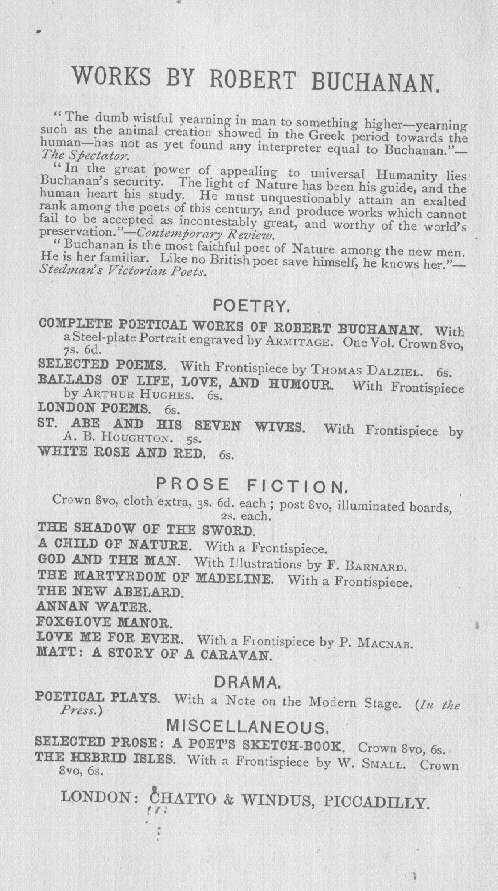ROBERT WILLIAMS BUCHANAN (1841 - 1901)
|
ROBERT WILLIAMS BUCHANAN (1841 - 1901) |
|
|
|
|
|
|
|
|
THE EARTHQUAKE |
 |
|||
 |
|||
|
THE EARTHQUAKE OR SIX DAYS AND A SABBATH
BY ROBERT BUCHANAN
“And the seventh angel poured out his vial into the air. . . .
THE FIRST THREE DAYS
London CHATTO AND WINDUS, PICCADILLY 1885 [The right of translation is reserved] _____
Ballantyne Press
_____
PREFATORY NOTE. The following work has been in preparation for years. ROBERT BUCHANAN. LONDON, November 13, 1885.
_____
PAGE |
|
|
|
_____
[Notes: The second volume of The Earthquake which Buchanan refers to in his prefatory note, was never published, presumably due to poor sales of this first volume. The only reference to The Earthquake in Harriett Jay’s biography is the following sentence from Chapter 23: “Since his wife’s death, in 1881, he had published two volumes of poetry—“Ballads of Life, Love, and Humour” (1882) and “The Earthquake” (1885), and both had met with scant recognition.” The actual earthquake which Buchanan mentions in his prefatory note occurred in Essex on 22nd April 1884. The following description is taken from the GeoEssex site: “The most destructive earthquake ever recorded in Britain occurred in Essex on the morning of 22 April 1884 and strongly shook most of the county. It is known as the Colchester Earthquake because the greatest damage was caused to Colchester, Wivenhoe and the towns and villages nearby. The tremor was felt over much of southern England and parts of France and Belgium, and its magnitude has been estimated at 5.2 on the Richter scale.The number of casualties is difficult to estimate, but it is doubtful whether any deaths or serious injuries can be attributed to the earthquake. There was, however, considerable damage to over 1,200 buildings in Essex. The earthquake was probably due to movement along a fault in the ancient Palaeozoic rocks under Essex, which would have affected the overlying cover of Cretaceous and Tertiary strata.” The Foxearth and District Local History Society has a more detailed description of the event including extracts from a report in the local newspaper, and the Colchester Archaeological Trust site has an article by Philip Crummy entitled ‘Virley Church: a survivor of the Essex earthquake of 1884’ which includes the following reference to the earthquake’s effects elsewhere: “In London, as in many places closer to the epicentre, the shock was fairly severe. The Houses of Parliament were violently shaken and a three-foot wave engulfed some boats in the Thames. Throughout much of the south-east of England, and in places as far away as Portsmouth, Birmingham, and Leicester, houses shook, windows rattled, furniture and crockery moved, church bells rang and clocks stopped. Even where the earthquake was too weak to cause any serious damage, the vibrations left many people feeling frightened and nauseous.” An explanation of the earthquake appeared in The Manufacturer and Builder magazine of June 1884 and it is also mentioned in Charles Fort’s New Lands. There is also an essay, ‘The Wivenhoe Earthquake’, by Ruth Baker, which discusses its astrological implications.] |
 |
|
The ancient parish church at Langenhoe after the 1884 earthquake.
Back to Poetry
|
|
|
|
|
|
|